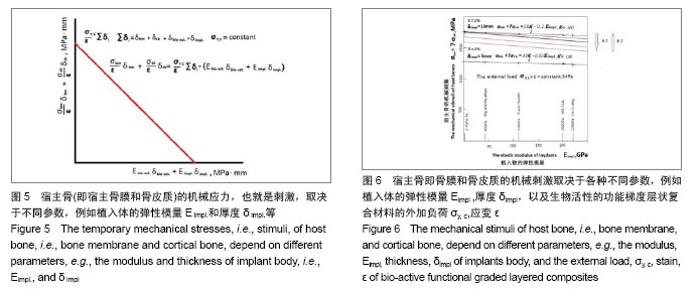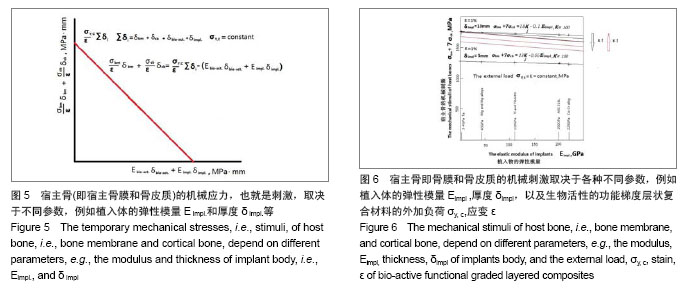Chinese Journal of Tissue Engineering Research ›› 2014, Vol. 18 ›› Issue (3): 357-364.doi: 10.3969/j.issn.2095-4344.2014.03.005
Previous Articles Next Articles
Bionic mechanics of customized cellular bio-magnesium scaffolds for large-area defects of femoral shafts and implants for orthopaedics surgery
Zhao Wei-min1, Li Bing-zhe2, Tang Liu-ding3, Peter Paul Müller4
- 1 Institute of Biomechanics and Biomedicine, Department of Orthopaedics, the Third Affiliated Hospital, i.e., Dongfang Hospital, Henan University of Science and Technology, Luoyang 471003, Henan Province, China; 2 Institute of Biomechanics and Biomaterials, Henan University of Science and Technology, Luoyang 471003, Henan Province, China; 3 Institute of Mechanics, Henan University of Science and Technology, Luoyang 471003, Henan Province, China; 4 German Center for Biotechnology Research, Department of Molecular Biotechnology, German Helmholtz Center for Infection Research, D-38124 Braunschweig, Germany
-
Online:2014-01-15Published:2014-01-15 -
Contact:Li Bing-zhe, Professor, Institute of Biomechanics and Biomaterials, Henan University of Science and Technology, Luoyang 471003, Henan Province, China -
About author:Zhao Wei-min, Master, Associate chief physician, Institute of Biomechanics and Biomedicine, Department of Orthopaedics, the Third Affiliated Hospital, i.e., Dongfang Hospital, Henan University of Science and Technology, Luoyang 471003, Henan Province, China -
Supported by:
CLC Number:
Cite this article
Zhao Wei-min, Li Bing-zhe, Tang Liu-ding, Peter Paul Müller. Bionic mechanics of customized cellular bio-magnesium scaffolds for large-area defects of femoral shafts and implants for orthopaedics surgery[J]. Chinese Journal of Tissue Engineering Research, 2014, 18(3): 357-364.
share this article
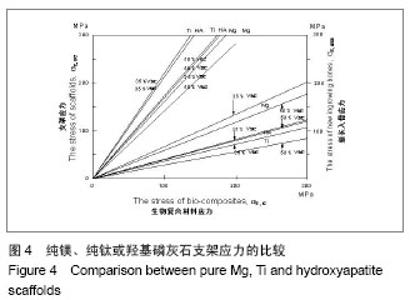
2.1 多孔支架中新长入骨受到的机械刺激取决于多孔支架材料的不同弹性模量和体积分数 如公式(7)所示,对股骨干缺损,新长入骨/多孔纯钛支架的复合材料的杨氏弹性模量EC=0.5×110+0.5×18=64 GPa,将比新长入骨大2倍多,其中纯钛的杨氏弹性模量ESC为110 GPa;新长入骨,假设为骨皮质,约18 GPa。多孔支架体积分数,假设约50%。这就意味着,当利用多孔金属支架时,例如新长入骨/多孔纯钛支架复合材料的强度σC 可能明显地增加。这种金属支架可能解决部分脱钙骨支架和人自体骨髓基质干细胞复合物,以及其他非金属支架(包括有机的和无机的)在植入人体早期缺乏一定力学强度的问题,从而有可能应用于负重的四肢骨缺损修复[48-50]。 正如从公式(8)所知,多孔支架材料弹性模量ESC愈小,多孔支架承受的负荷σZ, SC就愈小;而新长入骨承受的所谓机械刺激σZ,NIB明显增加,例如多孔纯镁支架ESC= 43 GPa,其支架体积分数VSC=50%,新长入骨的ENIB= 18 GPa,那么,假设生物复合材料应力,也就是外部载荷,例如人股骨干的σZ,C=100 MPa[51],那么,新长入骨所受的所谓机械刺激,即应力σZ, NIB=59.02 MPa;而纯钛多孔支架ESC=110 GPa,新长入骨所受的所谓机械刺激,即应力σZ,NIB=28.13 MPa(表1和图4)。"
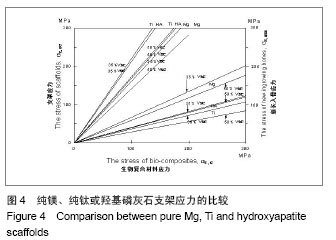
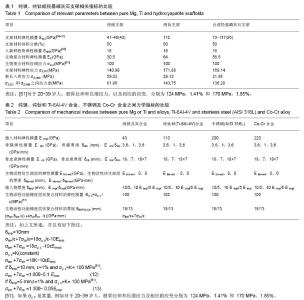
很明显,同多孔纯钛支架比较,多孔纯镁支架对新长入骨应力的遮挡效应将显著地下降。如果支架体积分数相同,见表 1所示,支架材料的弹性模量ESC愈大,支架负荷σZ, SC同新长入骨负荷σZ,NIB即所谓机械刺激,它们之间的差异愈大。这就意味着界面松弛,释放应力引起生物学固定被破坏等现象可能发生[36, 47]。 如果支架体积分数VSC愈小,新长入骨负荷σZ,NIB即所谓机械刺激愈大,它意味着支架对新长入骨的应力遮挡效应将减小。 众所周知,人骨应力减小导致钙和磷丢失,正如长时间太空旅行或无重力情况下发生的一切[52]。人骨生长或吸收取决于负荷应力,即所谓机械刺激,这是骨重新构建的本质[52]。换句话说,对多孔支架,所选支架材料弹性模量将是最重要的因素之一,其大小应该尽可能地接近宿主骨的弹性模量, 例如多孔金属钽(孔隙率 75%-85%,孔径 550 μm) 的弹性模量2.5-3.9 GPa[53],更接近于髋臼和股骨头内部松质骨的弹性模量,适合于髋臼修复和早中期股骨头坏死植入[54-56];但因其弹性模量过低,机械强度的局限性,通常不能用来制造负荷较大的下肢负重骨大面积缺损多孔支架。 可以得出结论:对于负重的组织工程骨多孔支架,目前来说纯镁是最佳选择,特别是客户定制的下肢负重骨大面积缺损多孔支架,以便解决植入部分脱钙骨支架和人自体骨髓间充质干细胞复合物早期过低强度问题[49-50]。应该强调的是存在其他可能性,也就是制造的多孔纯镁或镁合金支架具有仿生纳米涂层,其中包括生物大分子(例如Ⅰ型胶原蛋白等),生物矿物(例如羟基磷灰石及某些多肽等)[37-38]。显然,重建新骨/仿生纳米涂层/多孔生物镁支架之间的界面仿生力学问题需要解决[37-38]。 2.2 具有表面生物活性粗大孔隙功能梯度层状复合材料骨科植入物是未来发展方向 宿主骨/仿生纳米涂层/骨科植入体间的界面仿生力学问题分析,见图3和公式(9,11)所示[37-38],植入体弹性模量Eimpl(材料本身及表面微结构,例如表面粗大多孔隙,内部梯度层状复合板,仿生涂层等)和其于垂直受力方向分析截面上投影的板厚度δimpl之乘积愈小,宿主骨膜和骨皮质受到的机械应力或刺激σbm和σcb愈大,例如纯钛弹性模量107 GPa,合金Ti-6Al-4V 110 GPa,不锈钢(AISI 316L)200 GPa,Co-Cr合金 220 GPa等[1],相互比较(图5,表2和图6)。 当外部载荷增大,即σY,C表面生物活性功能梯度层状复合材料承受应力增大,宿主骨膜和骨皮质受到的机械应力或刺激即 σbm和σcb也增大;当表面生物活性功能梯度层状复合材料的弹性模量不变,而应变ε增大,宿主骨膜和骨皮质受到的机械应力或刺激即σbm和σcb也增大。 值得注意的是,对于板状植入体来说,δimpl减小,宿主骨膜和骨皮质受到的机械应力(或刺激)受Eimpl增大而引起变小趋于缓和,这是直线函数的斜率小(ε很小,约1%)所致;总之,功能梯度层状复合材料骨科植入物主体的弹性模量Eimpl增大时,宿主骨(同样是功能梯度层状复合材),例如股骨干等下肢负重骨,受到的应力遮挡效应变化不明显。起加固稳定和增强作用的功能梯度层状复合材料骨科植入物主体强度和刚性是更重要的性能;尽管如此,降低弹性模量的表面微结构,例如纤维网、粗大孔隙及仿生涂层等,对局部降低应力遮挡效应,增强对骨细胞生物相容性,以至于加强生物固定,无论如何是必要的(表2和图6)。因此具有仿生表面生物活性粗大孔隙的功能梯度层状复合材料骨科植入物是未来发展方向。"
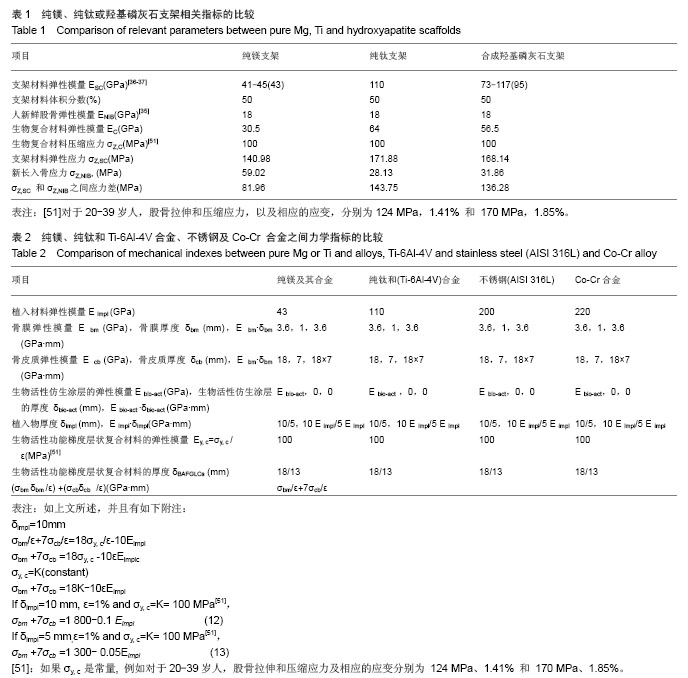
| [1]Mow VC,Huiskes R.Basic Orthopaedic Biomechanics and Mechano-biology,3/E. Simplified Chinese translation by Shandong Science & Technology Press, 2009:21-25.[2]Santos A,Bakker AD,Klein-Nulend J. Bone Quality Seminars: Ultrastructure: The role of osteocytes in bone mechanotransduction.Osteoporosis International with other metabolic bone diseases, Published online: 2 April 2009.[3]Wolff JD. Das Gesetz der Transformation der Knochen. Berlin(1892); Wolff J. The law of bone remodeling (translation of Wolff,1892), Berlin: Spring-Verlag(1986):126.[4]Cowin SC,Moss-Salentijn L,Moss ML.Candidates for the mechanosensory system in bone.J Biomed Eng.1991; 113:191-197.[5]Mullender MG,Huiskes R.Proposal for the regulatory mechanism of Wolff’s law. J Orthop Res.1995;13:503-512.[6]Mullender MG,Huiskes R.Osteocytes and bone lining cells: which are the best candidates for mechano-sensors in cancellous bone? Bone.1997;20:527-532.[7]Klein-Nulend J,Van der Plas A,Semeins CM,et al.Sensitivity of osteocytes to biomechanical stress in vitro.FASEB J.1995; 9:441-445.[8]Gowen LC,Petersen DN,Mansolf AL,et al.Targeted disruption of the osteoblast/osteocyte factor 45 gene (OF45) results in increased bone formation and bone mass.J Biol Chem.2003; 278: 1998-2007.[9]Balemans W,Ebeling M,Patel N,et al.Increased bone density in sclerosteosis is due to the deficiency of a novel secreted protein (SOST). Hum Mol Genet. 2001;10:537-543.[10]Feng JQ,Ward LM,Liu S,et al.Loss of DMP1 causes rickets and osteomalacia and identifies a role for osteocytes in mineral metabolism.Nat Genet.2006; 38:1310-1315. [11]Patrick CW Jr,Mikos AG,McIntire LV.Frontiers in Tissue Engineering.Pergamon, 1998.[12]Butler DL,Goldstein SA,Guilak F.Functional tissue engineering: the role of biomechanics.J Biomech Eng.2000; 122(6):570-575.[13]Witte F.The history of biodegradable magnesium implants: A review. Acta Biomaterialia.2010;6:1680-1692.[14]Reifenrath J,Palm C,Mueller P,et al.Subchondral plate reconstruction by fast degrading magnesium scaffolds influence cartilage repair in osteochondral defects. Transactions.30, S. 1347, Washington,D.C.,2005.[15]Witte F,Reifenrath J,Müller PP,et al.Cartilage repair on magnesium implants as scaffolds used as a subchondral bone replacement.Materialwissenschaft Und Werkstofftechnik. 2006;37(6):504-508.[16]Witte F,Kaese V,Haferkamp H,et al.In vivo corrosion of four magnesium alloys and the associated bone response. Biomaterials.2005;26:3557-3563.[17]Witte F, Hort N, Vogt C,et al.Degradable biomaterials based on magnesium corrosion. Curr Opin Solid State Mater Sci. 2008;12:63-72.[18]Lorenz C,Brunner JG,Kollmannsberger P,et al.Effect of surface pre-treatments on biocompatibility of magnesium. Acta Biomaterialia.2009;5(7):2783-2789.[19]Feyerabend F,Fischer J,Holtz J,et al.Evaluation of short-term effects of rare earth and other elements used in magnesium alloys on primary cells and cell line.Acta Biomaterialia.2010; 6:1834-1842.[20]Janning C,Willbold E,Vogt C,et al.Magnesium hydroxide temporarily enhancing osteoblast activity and decreasing the osteoclast number in peri-implant bone remodeling.Acta Biomaterialia.2010;6:1861-1868.[21]Witte F, Fischer J,Nellesen J,et al.In vivo corrosion and corrosion protection of magnesium alloy LAE442. Acta Biomaterialia.2010;6:1792-1799.[22]Hort N,Huang Y,Fechner D,et al.Magnesium alloys as implant materials – Principles of property design for Mg–RE alloys. Acta Biomaterialia.2010;6: 1714-1725.[23]Tamimi F,Le Nihouannen D,Bassett DC,et al.Biocompatibility of magnesium phosphate minerals and their stability under physiological conditions. Acta Biomaterialia. 2011;7: 2678-2685.[24]Willbold E,Witte F.Histology and research at the hard tissue–implant interface using Technovit 9100 New embedding technique.Acta Biomaterialia.2010;6: 4447-4455.[25]Salunke P,Shanov V,Witte F. High purity biodegradable magnesium coating for implant application. Mater Sci Eng B.2011;176:1711-1717. [26]Lichte P,Pape HC,Pufe T,et al.Scaffolds for bone healing: Concepts, materials and evidence.Injury.2011;42(6): 569-573.[27]Holzapfel BM,Reichert JC,Schantz JT,et al.How smart do biomaterials need to be? A translational science and clinical point of view.Adv Drug Deliv Rev.2013;65(4):581-603. [28]Hornberger H,Virtanen S,Boccaccini AR.Boccaccini. Biomedical coatings on magnesium alloys-A review.Acta Biomaterialia.2012;8(7):2442-2455. [29]Seitz JM,Eifler R,Stahl J,et al.Characterization of MgNd2 alloy for potential applications in bioresorbable implantable devices. Acta Biomaterialia.2012;8(10):3852-3864. [30]Krüger R,Seitz JM,Ewald A,et al. Strong and tough magnesium wire reinforced phosphate cement composites for load-bearing bone replacement.J Mech Behav Biomed Mater. 2013;20:36-44.[31]Kuhlmann J,Bartsch I,Willbold E,et al.Fast escape of hydrogen from gas cavities around corroding magnesium implants. Acta Biomaterialia.2012 pii: S1742-7061.[32]Dziuba D,Meyer-Lindenberg A,Marten Seitz J,et al.Long-term in vivo degradation behaviour and biocompatibility of the magnesium alloy ZEK100 for use as a biodegradable bone implant.Acta Biomaterialia.2012. [33]Tang LD,Zhang XB,Li BZ.Application of the equivalent transformation layering calculation model in heavy cross-section FGCs-Axis-symmetrical mechanics problems. Mater Sci Forum.2005;10 (475-479):1533-1536. [34]Tang LD,Zhu JM,Li BZ,et al.Interface biomechanical properties between femora and bioactive ceramics coatings prosthesis during the initial implant stage[C].CICC-4,2005.10 (650G05). [35]Li BZ,Dai KR,Tang LD et al, The opportunity and challenge that face bioactive functionally graded layer-like composites-its fundamental science problems and biomechanical methods[c].J of Med. Biomechanics. 2005; (20,suppl.):111-112.[36]唐六丁,朱坚民,李秉哲,等.生物活性陶瓷涂层假体植入股骨初期的界面生物力学分析[J].医用生物力学,2005,20(2):76-80. [37]李秉哲,雷万军,曹谊林,等.四肢组织工程骨新型支架的比较研究[J].组织工程与重建外科,2007,3(6):301-304,332. [38]雷万军,李秉哲,曹谊林,等.组织工程骨和外科人工植入物的仿生技术研究[J].中国组织工程研究与临床康复,2008,12(14): 2721-2726. [39]Zhao WM.In vivo investigation of pure magnesium in rabbit femor and subcutaneously. 2010 Forum for Bio-magnesium in Orthopaedics Surgery, SHANGHAI[40]From www.helmholtz-hzi.de[41]Lichte P,Pape HC,Pufe T,et al.Scaffolds for bone healing: Concepts, materials and evidence.Injury.2011;42(6):569-573.[42]Bose S,Roy M,Bandyopadhyay A.Recent advances in bone tissue engineering scaffolds.Trends Biotechnol.2012; 30(10): 546-554.[43]Alper MD. Biology and Materials? PartⅠBiology and materials synthesis.MRS Bulletin.1992;17(10):24-29.[44]Dujiardin E,Mann S.Bio-inspired Materials Chemistry.Adv Mater 2002;14(11):775-788.[45]Lachiewicz PF,Poon ED.Revision of a total hip arthroplasty with a Harris-Galante porous-coated acetabular component inserted without cement. A follow-up note on the results at five to twelve years. J Bone Joint Surg Am.1998;80(7):980-984.[46]Berer H.Handbuch der Mikroskopie.Berlin: VEB Verlag Technik, 1977. [47]Tang LD,Zhao WM,Li BZ.A study of interface biomechanical properties between femora and prosthesis.J Med Biomech. 2004;19(2):112-116.[48]曹谊林.组织工程的基本科学问题[J].生命科学,2005;7(2): 106-111. [49]Chai G,Zhang Y,Liu W,et al. Experimental study on the role of mesenchymal stem cells in clinic application of bone engineering.Xiandai Kangfu. 2002;6(22):3340-3341.[50]Chai G,Zhang Y,Liu W,et al.Clinical application of tissue engineered bone repair of human craniomaxillofacial bone defects. Zhonghua Yi Xue Za Zhi.2003;3(19):1676-1681.[51]陶祖莱.生物力学导论[M].天津:天津科技翻译出版公司,2000: 86-88,657-658. [52]程红,樊启昶,高崇明,等.生命科学导论[M].北京:高等教育出版社,2003:210-213. [53]Balla VK,Bodhak S,Bose S,et al.Porous tantalum structures for bone implants: Fabrication, mechanical and in vitro biological properties.Acta Biomaterialia.2010;6(8):3349-3359. [54]Gruen TA, Poggie RA, Lewallen DG, et al. Radiographic evaluation of a monoblock acetabular component.A multicenter study with 2 to 5 year results.J Arthroplasty. 2005;20(3):369-378. [55]Unger AS,Lewis RJ,Gruen T,et al.Evaluation of a porous tantalum uncemented acetabular cup in revision total hip arthroplasty: clinical and radiological results of 60 hips.J Arthroplasty.2005;20(8):1002-1009. [56]Tsao AK,Roberson JR,Christie MJ,et al.Biomechanical and clinical evaluations of a porous tantalum implant for the treatment of early stage osteonecrosis.J Bone Joint Surg. 2005;87 Suppl 2:2-27. |
| [1] | Wang Liang, Guo Yuxing, Wu Xun, Huang Hua, Yuan Guangyin, Zhang Lei. Antibacterial properties of Jiao Da Bio-Magnesium scaffolds in vitro [J]. Chinese Journal of Tissue Engineering Research, 2021, 25(16): 2506-2513. |
| [2] | Zhang Yanan, Yan Xia, Meng Zengdong. Zn and Mg increase the bioactivity and osteogenic induction of hydroxyapatite biomaterial in bone repair: clinical application and mechanism [J]. Chinese Journal of Tissue Engineering Research, 2020, 24(4): 606-611. |
| [3] | Sun Xirao, Sun Baozhai, Zhang Zhenbao. Combination of magnesium ion with mineralized collagen intervenes osteogenic differentiation of mouse preosteoblasts [J]. Chinese Journal of Tissue Engineering Research, 2020, 24(22): 3467-3473. |
| [4] | Ma Rui, Wang Jialin, Li Yongwei, Wang Wei. In vitro antibacterial activity and biocompatibility of a porous scaffold containing magnesium [J]. Chinese Journal of Tissue Engineering Research, 2020, 24(22): 3534-3539. |
| [5] | Sun Xirao, Wang Chengyue, Zhao Yuan, Zhang Zhenbao. In vitro corrosion and in vivo biosafety of pure magnesium film [J]. Chinese Journal of Tissue Engineering Research, 2020, 24(16): 2578-2584. |
| [6] | Wang Yang, Song Zhuoyue, Li Guangheng. Synergistic promotion of inflammatory chondrocyte reverse differentiation by the combination of curcumin and magnesium sulfate [J]. Chinese Journal of Tissue Engineering Research, 2019, 23(9): 1410-1415. |
| [7] | Yuan Bo, Wang Zhiwei, Tang Yifan, Zhou Shengyuan, Chen Xiongsheng, Jia Lianshun. Construction of polycaprolactone-tricalcium phosphate with different mixture ratios using three-dimensional printing technology and its osteoinductivity in vitro [J]. Chinese Journal of Tissue Engineering Research, 2019, 23(6): 821-826. |
| [8] | Wang Liang, Guo Yuxing, Huang Hua, Yuan Guangyin, Zhang Lei. Evaluation of biosafety of porous magnesium alloy scaffolds for jaw defects [J]. Chinese Journal of Tissue Engineering Research, 2019, 23(26): 4121-4128. |
| [9] | Li Li, Wang Xinling, Liu Suxin, Huo Yan. Effects of magnesium on proliferation, adhesion and apoptosis of endothelial progenitor cells in patients with preeclampsia [J]. Chinese Journal of Tissue Engineering Research, 2019, 23(21): 3371-3377. |
| [10] | Wei Wei, Liu Yanfei, Zhang Ling, Xiong Na . Self-assembling peptide hydrogel: hemostatic effect and mechanism [J]. Chinese Journal of Tissue Engineering Research, 2019, 23(2): 310-316. |
| [11] | Zhang Minbo, Peng Qifeng, Ma Yaping, Kong Weijun, Liao Wenbo. Physical properties and biocompatibility of 3D printed bone microparticle/poly(lactic-co-glycolic acid) scaffold [J]. Chinese Journal of Tissue Engineering Research, 2019, 23(14): 2215-2222. |
| [12] | Li Zhi, Tan Chunhua, Cai Xianhua, Wang Huasong, Ding Xiaoming, Zhao Yanhong. Fabrication and biocompatibility assessment of the scaffold with biomimetic interconnected macropore structure [J]. Chinese Journal of Tissue Engineering Research, 2019, 23(14): 2223-2227. |
| [13] | Bai Yulong, Gao Yufeng, Zhong Hongbin, Zhao Yantao, Guo Ruizhou, Li Li. Allogeneic and xenogeneic tissue repair materials: how to choose a suitable virus inactivation process [J]. Chinese Journal of Tissue Engineering Research, 2019, 23(14): 2261-2268. |
| [14] | Luo Kai, Yang Yafeng, Ma Teng, Xia Bing, Huang Liangliang, Huang Jinghui, Luo Zhuojing. Effects of perfluorotributylamine/alginate/bioglass biomaterials on viability and osteogenic differentiation of adipose-derived stem cells [J]. Chinese Journal of Tissue Engineering Research, 2019, 23(13): 1995-2001. |
| [15] | Wang Yuanyuan, Song Wenshan, Yu Dejun, Dai Yuankun, Li Bafang. Preparation and evaluation of fish skin acellular dermal matrix for oral guided tissue regeneration [J]. Chinese Journal of Tissue Engineering Research, 2019, 23(10): 1526-1532. |
| Viewed | ||||||
|
Full text |
|
|||||
|
Abstract |
|
|||||
